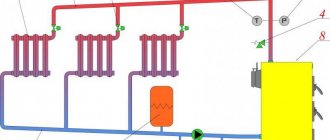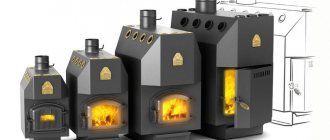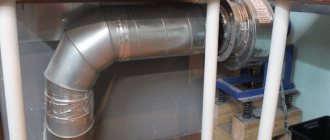Features of water heating in the garage
The difficulty of a warm hangar lies in its inconsistent operation. If the heating is turned off for a long time, the circuit may break due to freezing of water in the pipes.
The main feature of water heating in a room is to warm it up to a temperature of + 5-8 0C. This will provide the necessary warm-up to the car and prevent the development of metal corrosion.
Advice! Filling water heating pipes with antifreeze will prevent rupture of system elements when the garage is not constantly heated.
The scheme includes:
- boiler;
- radiators;
- line for supplying hot water and discharging cooled water.
The boiler's job is to heat the water that moves through the pipes to the heating radiators. The cooled liquid is returned to the boiler in reverse and the circuit is cycled.
Pros and cons of heating a garage with water
A warm room for a car saves it from corrosion, peeling paint, and freezing of lubricant. Heating a garage with a water circuit creates optimal storage conditions.
Experts often dispute the advantages and disadvantages of a warm room for a car. There is an opinion that in a heated garage in winter, snow accumulates on the bottom and walls, and when it melts it causes corrosive changes in the metal.
In any case, in a heated room, it is more comfortable for the car owner to carry out maintenance and repairs on a friend on wheels. Some car owners turn on the heating only during repair work, and the car itself is stored in an unheated room.
Knowing the advantages and disadvantages, the car owner independently decides how to store his car.
Cheap and fast garage heating: do it yourself
Obviously, it is not at all necessary to order a heating system for your garage from professionals. Here you can do it yourself, provided you fully comply with all safety measures. It is not difficult to purchase and install one of the devices listed in our top list. All of them have detailed installation instructions, and the store salesperson will certainly advise you on any questions you may have.
All that remains is to consider how to make heating in the garage with your own hands in the simplest and cheapest way.
Do-it-yourself air heating of the garage in winter
One of the cheapest and fastest ways to organize heating in a car box is air. Heat is supplied through pipes only to the place where a person works. This way you can save money by not using fuel to heat the entire garage.
In this device, heated air circulates through metal pipes and is supplied through grilles. The efficiency of such a system is more than 90 percent, and the design itself is extremely simple and easy to install. Warming up the room takes just a few minutes. The only negative is the drying out of the atmosphere, but you can get rid of this disadvantage just by ventilating the garage.
Video material on air heating:
Installation of a contour heating system
If your choice fell on a system with a water or antifreeze circuit, you will need to purchase the appropriate boiler and heating radiators. It is best to use metal batteries. Recommendations for this type of heating are in the following video:
Popularity record: heating a garage with a potbelly stove with a water circuit
As we have already said, potbelly stoves are by far the most popular heating device for car boxes. Among such systems, devices with a built-in water circuit occupy a special place. It’s easy to weld the potbelly stove yourself from thick steel, and make the water counter from a small-diameter metal pipe.
For your information! When starting to make your own stove, consider the type of fuel. To store firewood you need a large hole.
In order for water to circulate well in the system, a pump is required. But in principle, you can do without it if you arrange the pipes so that the liquid circulates in them by gravity.
An example of such a system in the video:
Water heating schemes in the garage
At the design stage of the circuit, the diameter of the pipes is determined. The higher its value, the more efficient the heating will be.
The thermostat increases or decreases the supply of hot water depending on the area of the heated room
Next, calculate the required number of radiators to warm the room. At the design stage, approximate fuel costs are determined. The choice is made on a cheaper and more accessible form of energy.
There are 2 types of heating systems: one-pipe and two-pipe
The water heating circuit consists of a boiler, pipes and radiators.
Red pipes – supply line, blue – return line
The water heated in the boiler flows through pipes into the heating radiators, the metal warms up, transferring heat to the air, which heats the room. The water cooled in the radiators is returned through the pipes to the boiler and heated. It's a continuous cycle.
Water heating is the most economical for heating a garage
In a private house, it is possible to combine the heating system of the garage and the house into one circuit by installing a switch that turns off the heating in the garage. This type is the most budget-friendly
The supply and return lines are located at a slope
Experts recommend installing a unified heating system in cases where the garage is located from the house at a distance not exceeding 40 m.
The heating system of the 2nd floor of the room on which the workshop is located provides for a sequential arrangement of radiators
The gravity scheme includes:
- expansion tank;
- boiler;
- main pipes;
- radiators.
In a gravity system, water is supplied to the radiators through risers. For the garage, it is advisable to install autonomous heating if it is remote from the house, in which case the costs of materials increase. Instead of radiators for heating the garage, you can use pipes with a diameter of 5 to 10 cm. In the hangar, you can install a heated floor, having equipped it with a switch. Complex heating is being installed in a garage cooperative.
Video: different heating options from experienced garage workers
It’s worth watching additional video materials to evaluate the advantages and disadvantages of different methods and to visualize everything clearly.
This video discusses the option of organizing a heating system in a garage on your own, with minimal investment.
The following video tells about the operation of the fireplace stove.
Of particular interest is a furnace that operates on waste oil. It is quite possible to make it with your own hands, and it works on already used oil. There are, of course, some nuances here. But in general, this method is quite rational and safe if it is possible to organize timely cleaning of the waste in a special installation. The arrangement and manufacture of a boiler for heating during mining is described in the following video.
A boiler in a garage will be an excellent solution for organizing a heating system. This will allow you to create comfortable conditions in the garage at any time of the year, work there with high efficiency, and carry out vehicle inspections and repairs.
Methods for water heating of a garage
The choice of fuel significantly influences the heating scheme in the room. The frequency of operation of the circuit should be taken into account. If the garage is located far from the house and is not heated daily, then during severe frosts the pipes and radiator may rupture. At the design stage, you should carefully consider the type of boiler and type of fuel.
There are several types of fuel:
- gas;
- solid fuel (coal, firewood);
- liquid fuel (used technical oil);
- electricity.
Attention! Solid and liquid fuels require additional storage facilities for storage.
The choice is made based on the cost of fuel and autonomy.
Water heating in a garage without electricity
The most common fuel in the private sector is gas. The advantage of this type is its low cost and availability. Gas heating does not require constant monitoring. With an uninterrupted gas supply, continuous heating is ensured.
However, if the gas pipeline does not pass through the area in which the building is located, they choose a different type of fuel, since it is very expensive to install a gas line.
A gas boiler for autonomous heating is not a cheap pleasure, especially when it comes to heating a garage
Liquid fuel is a low-budget type. The big disadvantage of this heating option is the need for a place to store used oil. You will need a large number of barrels or canisters and a place where you can store all the supplies. This is a fire hazard.
If you have a boiler for liquid fuel, you must constantly monitor its filling level, so you will have to visit the garage often to prevent the heating pipes from bursting
A solid fuel boiler will help you set up water heating in your garage using wood, coal, garbage or pressed briquettes. This option is suitable if the owner can visit the hangar every day and throw a portion into the firebox. After all, in the garage it is enough to ensure a positive temperature; there is no need to warm up the room too much. If a new portion of fuel is not added in a timely manner, the system may freeze and the pipes may burst.
A solid fuel boiler requires a constant portion of fuel, otherwise the system will cool down
For the hangar, you can install water heating using a potbelly stove. This oven is designed for a room up to 30 m2.
Water heating in the garage from electricity
An electric boiler is the most optimal option for a water heating scheme in a room. There is no need for an additional pipeline or storage area to store fuel.
An electric boiler provides reliability and comfort and does not require additional installation of a chimney or supply
Advantages of an electric boiler:
- compactness;
- reliability;
- does not require installation of a supply line;
- does not require the construction of a chimney;
- the device is equipped with a safety system: in case of overheating, the system will turn off;
- can operate on battery power during an emergency shutdown;
- In the event of an emergency power outage, the boiler will start working on its own.
Despite the high cost of electricity, the choice of this heating scheme is optimal, since it is enough to warm the air in the room to positive temperatures, and little fuel is required.
The better to heat or the choice of energy carrier
In 99% of cases, garage buildings are not connected to centralized heating networks or main gas, so owners have to choose autonomous heating methods. To heat a garage, you can use 4 groups of energy carriers:
- various types of solid fuel - firewood, coal, briquettes, agricultural and other combustible waste;
- diesel fuel, waste oil;
- electricity;
- liquefied gas in cylinders.
Advice. When you start choosing an option for heating your garage in winter, keep in mind an important rule: the more expensive the energy source, the easier and cheaper it is to organize heating that is convenient to use. Conversely, cheap or free fuel in the form of waste and garbage will bring a lot of trouble - labor costs and initial financial investments.
Solid fuel combustion
Wood and various waste are the cheapest fuel for heating, and in some cases it is available completely free of charge. In the southern regions, which are not rich in forests, another type of fuel is widely used - small agro-industrial waste.
For reference. Agricultural waste consists of small particles sifted from grain crops. These are pieces of stems, weeds chopped by a combine, straw and other waste. The energy price is very attractive and starts from 20 USD. e. for 1 ton.
After cleaning the grain, waste remains that is used for heating.
We recommend: Flushing the heating system of an apartment building
If you decide to heat your garage with solid fuel in the winter, get ready to deal with the following issues:
- purchase or manufacture of a furnace (ideally a boiler);
- chimney installation;
- storage of firewood, coal or waste;
- labor costs for preparation, combustion and soot removal.
Storing firewood in the garage is not a very convenient solution
The gain is in money and excellent heating of a room of any size, the losing points are listed above. Add here the time for kindling and warming up (0.5-1 hour). Hence the conclusion: cheap heating with solid fuel is suitable for owners of garages and boxes who stay there for 4-6 hours or more every day.
Potbelly stove for heating a garage
Potbelly stoves are the most primitive stoves that began to be actively used at the beginning of the last century. Then their popularity sharply decreased due to the spread of centralized heating. However, potbelly stoves are still used, because they are practically the cheapest way to heat a garage.
The potbelly stove is made of metal. The largest part is occupied by the chamber into which the fuel is thrown. The room warms up due to the contact of the stove walls with the surrounding air. Not the least important role is played by the pipe, which also accumulates heat. To prevent heated combustion products from immediately flying out into the street, a pipe of a clearly defined diameter is used, due to which the warm gases make several revolutions in the vertical plane. This allows you to make maximum use of the heat of combustion of the fuel (efficiency reaches 60-80%) and effectively suck in the air necessary for the fuel to burn completely. The diameter of the pipe in mm should be 2.7 times greater than the volume of the stove in liters.
It is important that the chimney has a complex shape: first there is a vertical insulated part, then a horizontal or inclined part, the so-called. hog, which provides up to a quarter of the heat received, because the flue gases burn out here. Potbelly stoves are sold ready-made: there are both the simplest and most primitive options, as well as sophisticated designer ones. If you have the skills, you can assemble a potbelly stove yourself from a barrel or sheet metal.
Advantages:
- a potbelly stove can be heated with any solid fuel, but wood is usually used;
- low price and low cost of operation;
- relatively high efficiency;
- allows you to quickly warm up the room and dry the air in it;
- There are models that can also be used as a stove. They will come in handy for those who spend even too much time in the garage.
Minuses:
- the need for constant monitoring of work;
- high fire danger;
- Suitable for small spaces only;
- the air cools quickly;
- it will be impossible to get rid of the specific smell;
- the need for regular chimney cleaning.
Solid fuel boiler
This is a more expensive, but at the same time, safer and more effective solution. The principle of operation is simple: fuel is burned in the firebox, a container with coolant is heated, which is supplied through pipes and radiators. improved types of boilers are increasingly used
- a pyrolysis boiler has two combustion chambers, in the first the firewood smolderes at a high temperature due to the fact that the amount of air is insufficient. The combustion product is pyrolysis gas, which is burned in the second chamber, releasing much more heat than just wood. The boiler efficiency increases to 90%, and one portion of firewood lasts for 10-13 hours;
- Pellet boilers are fired using pellets obtained from wood waste. They are placed in a bunker, from where they are fed into the firebox in doses. The boiler efficiency reaches 95%; fuel can be loaded once every few days.
The body of solid fuel boilers is made of cast iron or steel. Pyrolysis and pellet boilers are, of course, very convenient, but they are expensive. If funds allow, you can afford such a purchase - it will soon pay off
.
Brick oven
Building a brick oven in a garage is a long, expensive and painstaking task. The fuel for such a stove is usually wood, but coal can also be used. The principle of obtaining heat is still the same. The fuel burns, heats the walls of the stove, and they heat the air. A good option for small spaces. Brick takes longer to warm up than metal, but it also cools more slowly.
Stove Buleryan
The Buleryan stove is often confused with a potbelly stove and a regular wood-burning stove. She actually absorbed a little bit of both. The operating principle is based on convection. The design assumes the presence of pipes at the base of the furnace and in the upper part. Cold air enters through the bottom of the stove, receives heat from the chamber where the fuel is burned, and exits, already heated, through the top. The pipes are 2/3 soldered into the furnace body to ensure maximum heat transfer. The special design of the firebox and chimney allows you to extract maximum heat from fuel combustion. The presence of a chamber for pyrolysis combustion of fuel plays a significant role here. Combustion products are removed through the chimney.
Advantages:
- rapid heating of the room due to convection and heat transfer from the surface of the stove;
- compactness;
- there is no need to frequently add firewood;
- higher safety compared to a potbelly stove.
Minuses:
- price;
- complexity of chimney installation;
- the need for frequent cleaning of soot.
Use of mining and diesel fuel
Heating a box or garage with diesel fuel purchased at a gas station is expensive and extremely unprofitable. An exceptional option is to heat a small area of the room where work is being done using a portable heater, whose characteristics are described in a separate material.
Waste oil is a more financially economical energy carrier, although not the cheapest. This option can be seriously considered when used oils can be obtained at a reduced price. What are the features and pitfalls here:
- Homemade potbelly stoves are used to burn liquid fuel in various types of mines. The safest is a drip stove, which you can order from craftsmen or do it yourself.
- A chimney installation is required.
Drip-type exhaust boiler with forced air supply - Oil containers take up less space than firewood. They are usually placed in the basement.
- The workings need to be settled and filtered.
- The inevitable companions of liquid fuel heating are smell and dirt, although this is not critical for a garage.
- Homemade waste oil stoves are considered a fire hazard.
Note. Due to their cheapness and simplicity, the oil miracle stoves shown in the photo have become especially popular. They tend to shoot flames when the fuel contains a small amount of water or antifreeze, causing a fire.
The advantages of using mining are high heat transfer, quick ignition and warming up of the garage box, ease of use (it’s easier to add oil than to chop and carry wood). The conclusion is this: if fuel is inexpensive, or you spend a little time in the garage, then liquid fuel is a suitable option. The initial investment is comparable to wood heating.
When using diesel fuel, it is worth considering the option of a factory-made diesel air heater of the “Planar” type, shown in the photo. With a fuel consumption of 250 ml in 1 hour, the unit develops heat transfer of up to 2 kW. There are also more powerful heaters - 3 and 4 kW with diesel consumption of 0.37 and 0.5 l/h, respectively. Price – within 330 USD. e.
Autonomous diesel-powered air heaters designed for cars
Electrical heating
Heating with electricity is the most comfortable and cheapest option in terms of initial investment. But during operation you will have to pay the full tariff - it makes no sense to install a two-zone meter, you are not going to work in the garage at night.
Let's list all the advantages of electric heating:
- Heating with electricity is convenient and safe. There is no dust, dirt or odors, no need to carry firewood or barrels of fuel.
- There is a wide selection of different air-type electric heaters on sale: convectors, oil radiators, infrared panels and heat guns.
- You can make a water heating system with an electric boiler (if the power limit allows).
- Heating of the garage begins immediately after turning on the heater; a comfortable temperature for work is reached in just half an hour (again, when there is enough power).
An inexpensive portable fan heater can heat only part of the room where work is being done
There are only two disadvantages, but they are critical: the price of electricity and the limitation of the power consumption limit, which does not allow installing an effective heat source. For example, if the contract with the management company specifies a figure of 3 kW, then a convector with only 2 kW is installed, which is not capable of properly heating the garage in the winter.
For reference. Sometimes car enthusiasts use homemade “goats” and fan heaters in the pits, despite the restrictions. Why you can’t do this: there is a danger of the wiring catching fire, the neighbors’ voltage drops, and if employees check the electrical networks, you will face a large fine or shutdown.
Electric heating is an option for short stays in the garage. They came, turned on the heater, completed the intended work in 1-2 hours, turned off the heating and left. If you turned the room into a workshop where you spend your working hours, you will have to pay significant amounts for energy consumption.
A standard wall convector heats the air in the room much slower than a fan heater
Gas heating
This method of heating a vehicle storage space is acceptable for residents of the Russian Federation, where the retail price of liquefied gas is quite low. It will be too expensive for Ukrainians to heat their garages with propane.
Autonomous heating from gas cylinders is as safe and comfortable as electric heating. Moreover, in the Russian Federation the cost of energy is lower. But there are a number of pitfalls here:
- you need to place the propane tank somewhere so it doesn’t interfere with your work;
- you will have to periodically take the tank to refuel;
During operation, the tank freezes over, causing the gas supply to deteriorate. - To burn propane, you need factory-made equipment; making gas burners yourself is strictly not recommended;
- you will need a chimney pipe to the street.
If you add up the financial costs, the problems of organizing such heating and refueling cylinders, then the negative aspects will cover up some of the positive aspects of ease of use.
Watch this video on YouTube
A comparison of the cost of 1 kW of heat obtained from various energy sources in Russia and Ukraine is published on this page.
Types of water heating garage
Water heating in a garage without a pump can be achieved using a gravity heating system.
There are 2 schemes:
- single-pipe;
- two-pipe.
Single-pipe water heating in the garage
Water heating in the garage from the stove is equipped using a single-pipe scheme. This scheme ensures the sequential passage of coolant through the radiators and return to the boiler.
A single-pipe heating system is easy to install and does not provide uniform heating of radiators
A significant disadvantage of the single-pipe scheme is the uneven distribution of heat. The first radiators will be significantly warmer than the last ones. Experts say that this problem is acute in multi-story buildings and less noticeable in single-story buildings.
Two-pipe water heating in the garage
In a hangar with a large area, experts recommend installing water heating using a two-pipe system. The first pipe pumps heated coolant to the radiators. The second drains waste fluid from the batteries back into the boiler.
The two-pipe system ensures uniform distribution of coolant throughout all radiators
The temperature of the radiators will be uniform, which will ensure uniform heating of the air. The disadvantage of this scheme is complex installation and a large number of pipes and shut-off elements, which increases its cost.
How to make water heating in a garage
Arranging water heating from a potbelly stove in the garage is advisable if the area does not exceed 30 m2.
To install the system you will need:
- oven or boiler;
- cast iron radiators;
- metal pipes with a diameter of 5-10 cm for arranging the main line;
- locks, screws, fasteners.
The number of radiators and sections in them is determined based on the heated area of the building and the expected fuel consumption. Standard formula: 1 equals 100 watts. Calculations for 20 m2: 100*20=2000 W. The package indicates the heat transfer index of 1 section, for example, for cast iron - 120 W. 2000/120= 16.67 sections. This formula is used to heat a living room. It is not necessary to warm up the garage to a temperature of 20 0C, so experts advise dividing all calculations by 2. For a room of 20 m2, 16.67/2 = 8.33 sections will be required. The value is rounded up or down.
Attention! The diameter of the pipe affects the heat transfer. The higher the value, the more efficient the heating of the room and the lower the fuel costs.
During the installation process, metal pipes are assembled into the system using a welding machine, and plastic pipes using a soldering iron. For natural circulation of the coolant, the pipes are placed at a slope.
The water heating circuit assumes the presence of an expansion tank. It is made from a canister or other plastic or metal container. In the upper part of the tank there is a hole for adding coolant, as the liquid heats up and evaporates.
The boiler is installed in a permanent place and pipes are supplied
Install the boiler. Pipes and, if necessary, a chimney are connected to it.
The boiler is installed in a permanent place and pipes are supplied
Radiators are hung on fasteners, evenly distributed around the perimeter of the room. The distance from the floor is at least 15 cm. A gap of 5 cm is left between the wall and the battery.
Radiators are hung from the wall and main pipes are supplied
Using main pipes, the entire structure is connected into a single circuit. When welding or soldering pipes, experts recommend paying attention to the quality of the seams. The circuit is filled with coolant and turned on for testing.










